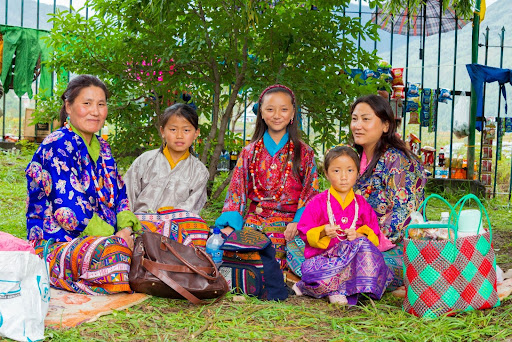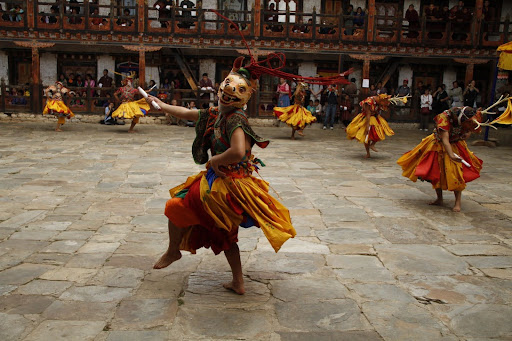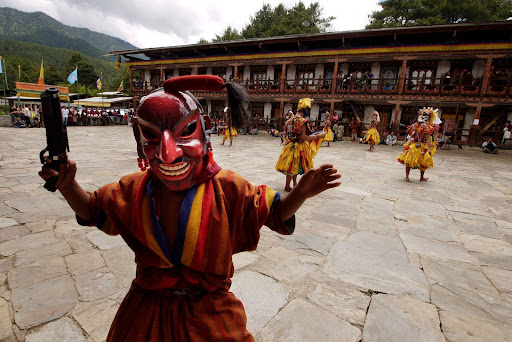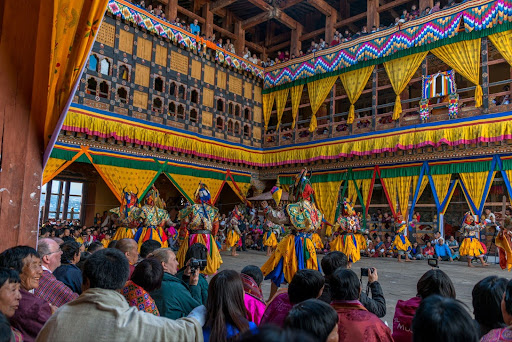Welcome to the land of dragons, where mysticism meets merriment, and festivity dances hand in hand with tradition! Bhutan's Tshechu is not just any ordinary festival; it's a kaleidoscope of colors, a symphony of laughter, and a carnival of culture. So buckle up as we embark on an exhilarating ride through the enchanting world of Tshechu, where every moment is a celebration of life, love, and the spirit of Bhutan.
Tshechu, also known as the Mask Dance Festival, stands as Bhutan's most important religious festival. Occurring yearly across the country's monasteries and dzongs, Tshechu pays homage to Guru Rinpoche, also known as Padmasambhava, the revered "Lotus-Born Teacher" credited with introducing Tantric Buddhism to Bhutan in the 8th century. For the locals, Tshechu represents a period for communal gatherings, entertainment, receiving blessings, and seeking spiritual purification to absolve sins.
At a Tshechu festival, spectators adorn themselves in their finest hand-woven kiras and ghos, creating a stunning tapestry of colors and textures that reflect the essence of Bhutanese craftsmanship. Prepare to be awestruck by the masterful weaving techniques and breathtaking combinations on display, as each intricately crafted garment tells a story of tradition, artistry, and cultural pride. From the vibrant hues of the kiras to the elegant draping of the ghos, every attire worn at a Tshechu festival is a testament to the beauty and splendor of Bhutanese textile traditions.

The Legends and Lore
Legend has it that long ago, in the mystical mountains of Bhutan, Guru Rinpoche , the great saint, performed miraculous dances to banish demons and bring blessings upon the land. These dances, known as cham, became the heart and soul of Tshechu, marking the birth anniversary of Guru Rinpoche. Imagine the air filled with the beat of drums, the flutter of colorful costumes, and the laughter of joyous souls as they come together to honor their beloved saint.
The Dance of the Deities
At Tshechu, prepare to be dazzled by the mesmerizing cham dances, where monks and villagers alike don ornate costumes and elaborate masks to portray gods, goddesses, and mythical creatures from Buddhist folklore. From the graceful movements of the Black Hat Dance to the dramatic reenactments of ancient battles, every step is imbued with symbolism and spirituality, weaving a tapestry of tradition that transcends time.
About the Sacred Cham Dances
The highlight of the festival is the sacred Cham dances performed by both laity and monks. Envision monks and local participants adorned in resplendent attire, gracefully interpreting melodies like "Dance of the Lords of Cremation Grounds", "Dance of the Terrifying Deities", and "Dance of the Noblemen and the Ladies"! It's akin to stepping into a realm where virtue unfailingly triumphs over malevolence.

The Bhutanese hold a profound belief that these dances transcend mere performance; they are conduits of spiritual elevation! By bearing witness to these sacred re-enactments of events that took place during the life of Padmasambhava – mostly depicting goodness triumphs over evil –, individuals perceive themselves as blessed, enlightened, and cleansed, as if they have undergone a profound spiritual metamorphosis!
Moreover, let us not overlook the musical accompaniment—a melodic fusion of traditional folk compositions harmonized by the rhythmic resonance of cymbals, drums, flutes, and even the evocative echoes of yak-horns! It manifests as a symphonic celebration of tradition and jubilation that resonates deep within the soul.
Yet, there is more to these performances than meets the eye! The dancers, adorned with intricately crafted wooden masks, do not merely serve as visual embellishments; they embody animals, formidable deities, and the diverse manifestations of Guru Rinpoche himself! According to ancient lore, Guru Rinpoche is said to have assumed eight distinct forms, each bearing its own distinctive essence and appearance. Among these, the countenance of Guru Rinpoche's wrathful form stands out as the most iconic, poised to subdue any unruly spirits with its stern countenance!
About Atsaras
If you attend a Bhutanese tshechu, expect to see comical characters prancing around. They wear a red mask with a hawkish nose, a giant phallus hangs from their forehead. These are Atsaras. The word "Atsara" derives from the Sanskrit word "Acharya", which means holy Indian master. Some people think of them as clowns. While it is their job to entertain the crowd, and sometimes they do that with comedy, it is also their job to encourage the audience spiritually — to forget their burdens and unleash their free spirit. They are also the master of ceremony as they perform crowd-control and ensure that the tsechu runs smoothly.
Ultimately, Atsaras are storytellers. They provide the background story during the masked dances.

About Thongdrel
The Thongdrel is a sacred religious artifact in Bhutan, symbolizing "liberation at sight." It is a massive silk appliqué, often depicting Guru Rinpoche or other Buddhist deities, and is displayed during religious festivals, particularly Tshechus. Just viewing the Thongdrel is believed to grant blessings and spiritual merit, helping individuals attain liberation from the cycle of rebirth.
Thongdrels are meticulously handcrafted by skilled artisans and monks, often taking months or years to complete. They are only unveiled during special occasions, usually at dawn, for a few hours before being carefully stored away to protect the delicate fabric.
One of the most famous Thongdrels is displayed at the Paro Tshechu, drawing large crowds of devotees and tourists. The Thongdrel is a symbol of Bhutan’s spiritual and cultural heritage, serving not only religious purposes but also fostering community unity and preserving traditional art forms.
Regional Revelries
Across the valleys and hills of Bhutan, each region adds its own spice to the Tshechu festivities. In Paro, witness the grand spectacle of the Guru Thongdrel unfurling at the Paro Tshechu, a breathtaking moment that sends shivers down your spine. In Punakha, join the locals in the " Dance of the Noblemen and the Ladies," where laughter and cheers echo through the valley as performers twirl and spin in perfect harmony during the Punakha Drubchen.
Crafts, Cuisine, and Cultural Delights
As you wander through the bustling marketplaces and village squares, you'll be tempted by the tantalizing aromas of Bhutanese delicacies wafting through the air. Sample savory momos, indulge in buttery ema datshi (chilli cheese), and wash it all down with a sip of ara, the local rice wine. And don't forget to pick up some exquisite handicrafts, from intricately woven textiles to hand-carved wooden masks, as souvenirs of your unforgettable journey.
Bhutan's Tshechu continues to captivate and inspire both locals and visitors alike with its vibrant colors, sacred rituals, and profound spiritual significance. As the kingdom navigates the complexities of modernity and globalization, it is essential to strike a delicate balance between preserving age-old traditions and embracing the opportunities of the future. By safeguarding the integrity of Tshechu and fostering cultural appreciation and understanding, Bhutan can ensure that this cherished festival remains a beacon of cultural heritage for generations to come. The spirit of Tshechu is resilient, and the bonds of tradition run deep in the hearts of the Bhutanese people.

How Long is the Tshechu Festival in Bhutan?
A tshechu typically lasts for four or five days depending on the location. It is celebrated on the tenth day of a month of the Tibetan lunar calendar corresponding to the birthday of Guru Rimpoche. However, the exact month of the Tshechu varies at different dzongs and also from year to year. The most popular tshechus festivals for tourists are Paro Tshechu, Punakha Drubchen, and Thimphu Tsechu.
View Festival CalendarWhat Are the Do’s and Don’ts of Tshechu Festivals in Bhutan?
If you're new to attending a tshechu festival in Bhutan, you may be curious about what to anticipate and the appropriate etiquette for the event. Firstly, it’s important to understand that the event grounds where the tshechus are held are sacred places and keep in mind that the dances, be it laymen or monks, are in a state of meditation. Therefore, respect is of utmost crucial when we are attending a tshechu.
Here are some etiquette to be observed when attending a Tshechu:
Dos:
- Respect the religious significance of festivals, which are sacred events.
- Maintain a quiet and respectful demeanor while observing the festivities.
- Honor the consecrated ground by refraining from eating, drinking, or smoking.
- Observe the dancers with reverence and appreciation for their spiritual devotion.
- Adhere to common courtesy when photographing dances or fellow onlookers.
Don'ts
- Avoid obtrusive or disrespectful behavior, as festivals are not entertainment events.
- Refrain from talking or laughing loudly at inappropriate times, as it disrupts the meditative atmosphere.
- Do not flash cameras or intrude on the dance space, as it detracts from the spiritual experience.
- Remember that festivals are not tourist attractions and should not be treated as such.
- Do not impair or infringe on the beauty and sacredness of the ritual by engaging in inappropriate conduct.
